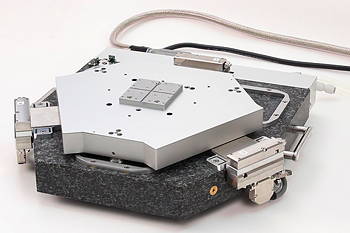The technology is being developed jointly by the micropositioning specialist PI (Physik Instrumente), the Institute for Microelectronic and Mechatronics Systems (IMMS) and the Department of Mechatronics at Ilmenau University of Technology.

The platform (above) can move objects linearly or rotate them with “a previously unattainable accuracy,” according to PI. The passive platform needs no cable connections, or conventional mechanical or air bearings. It operates with a high level of stiffness.
The platform’s position is measured with nanometre or microradian resolution using a six-dimensional sensing system that includes capacitive sensors to measure vertical or tilting movements, and a two-dimensional, optical incremental encoder for XY motion and rotation.
The prototype system currently has an operating envelope of 100mm x 100mm x 0.15mm. It can accelerate at up to 2m/s2 and achieve a maximum velocity of 100mm/s, with nanometre precision. It can also tilt or rotate though an angle of up to 0.25 degrees.
A digital motion controller, based on a modular system from PI, controls the platform’s movement in all axes. It can process different geometry files as well as co-ordinating transformations.
According to PI’s head of advanced mechatronics, Dr Rainer Gloess, the current platform can achieve a positioning resolution of 10nm. “If the system moves on a circular path with a diameter of 100nm, for example, the maximum deviation from the ideal path is only a few nanometres,” he adds.
Nanometre-level positioning is expected to become increasingly important in sectors such as the semiconductor industry, life sciences and biotechnology.
At present, for example, inspection and manufacturing systems in the semiconductor industry normally rely on air-bearing technologies and magnetic linear motors. However, such systems cannot meet the demand for precision in the nanometre range. In addition, they reach their limits in applications operating in vacuums or in nitrogen atmospheres.
Because the levitating nanopositioning system avoids direct contact between moving parts, it does not generate particles and can therefore be used safely in vacuums.
